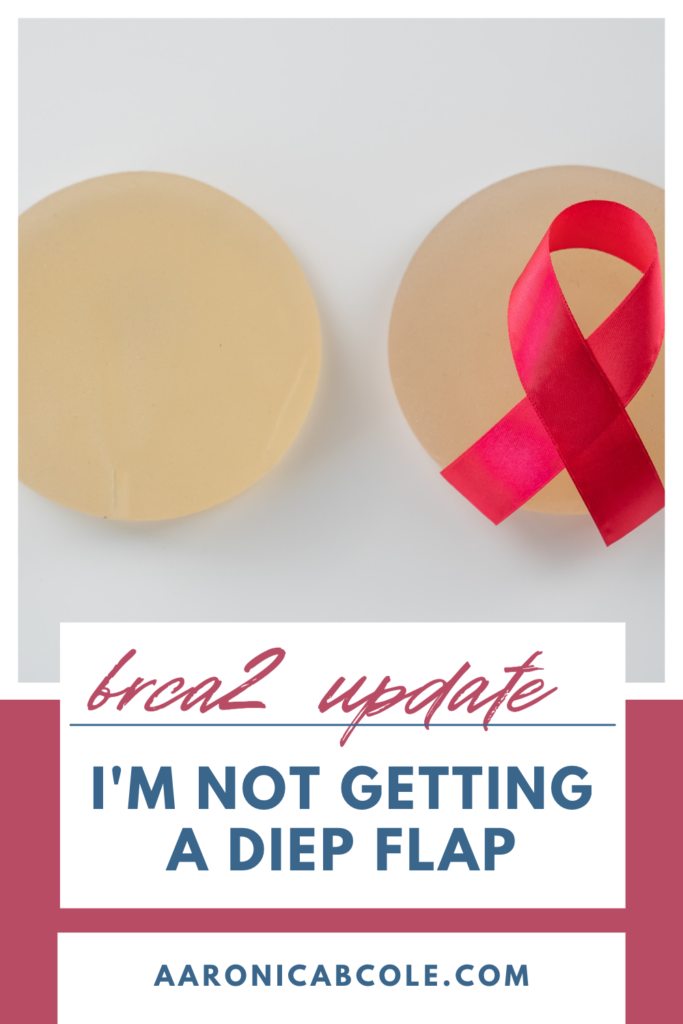On June 5, 2023, I’ll be getting a double mastectomy with reconstruction as preventative surgery after testing positive for the BRCA2 gene. I already knew going into the surgery that I wanted a reconstruction. I like having boobs and I want to continue to have them. There are so many options out there and the DIEP flap was top of the choices for me but I’m opting out of it for good reason.
Why? Because I have hidradenitis suppurativa.
Wait… What’s a DIEP Flap?
A DIEP flap, or deep inferior epigastric perforator flap, is a type of breast reconstruction surgery that uses a woman’s own abdominal tissue to create a new breast after mastectomy. During the procedure, a plastic surgeon removes excess skin and fat from the lower abdomen (similar to a tummy tuck) and uses this tissue to create a new breast mound. The blood vessels that supply the tissue are carefully preserved and reconnected to blood vessels in the chest using microsurgical techniques. Because the procedure uses a woman’s own tissue, the resulting breast has a more natural feel and appearance than breast implants. Additionally, the surgery removes excess tissue from the abdomen, resulting in a flatter, more toned abdominal appearance.
Now when I learned about this, I was like, “wait… I can get a tummy tuck AND new boobs at the same time??!?! Sign me up!!!” I was a little excited about the prospect.

Ok… Now What is Hidradenitis Suppurativa?
Hidradenitis suppurativa (HS) is a chronic skin condition that affects the hair follicles and sweat glands in areas of the body with skin-to-skin contact, such as the underarms, groin, and buttocks. HS causes painful, inflamed, and sometimes infected bumps or lesions that can lead to scarring and the formation of tunnels under the skin. The exact cause of HS is not well understood, but it is thought to be related to a blockage or inflammation of the hair follicles and sweat glands. HS is more common in women and typically begins after puberty. It is often a long-term condition that can be difficult to manage, and it may have a significant impact on quality of life. Treatment options for HS may include antibiotics, anti-inflammatory medications, topical creams, surgical removal of the affected skin, and lifestyle modifications, such as weight loss and smoking cessation.
What does having a DIEP flap have to do with HS?
HS can affect the skin in areas of the body with skin-to-skin contact, such as the abdomen, and this may make the DIEP flap procedure more challenging. Additionally, the chronic inflammation and scarring associated with HS may increase the risk of complications after surgery. However, in some cases, the benefits of DIEP flap breast reconstruction may outweigh the risks for women with HS. For example, the procedure can provide a natural-looking and feeling breast reconstruction that can improve the quality of life for women who have undergone mastectomy.
I’ve had cysts and tunneling in both my stomach area and my breasts which makes me really apprehensive about doing this transfer. Now if I didn’t have some pre-existing tunneling, I would definitely opt for the DIEP flap–a tummy tuck AND boob job at the same time? Yes, yes, yes!!! But I also know that if I were to get cysts in my breasts AFTER this procedure I would be filled with anxiety and a lot of additional emotions.
So I’m opting out.
Initially, I didn’t feel strongly about this though. Why? Because at the end of the day, I know I wanted a reconstruction. I love having breasts–side boob, underboob, cleavage… I love it all. But it feels like the DIEP flap is pushed hard by those who’ve received them and while I would love to have one, it’s not best for my health. I almost didn’t want to share that I wasn’t going to get one because I didn’t want to feel like I was letting the community down, but I have to do what’s best for me.
If you’re debating on whether or not the DIEP flap is for you, follow your health. Seriously.






